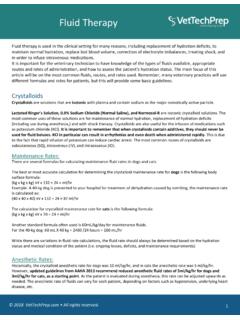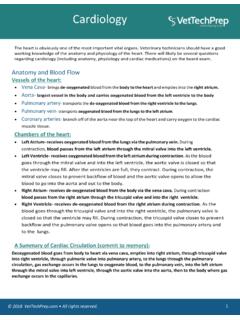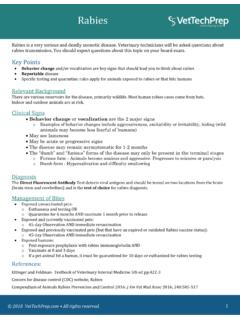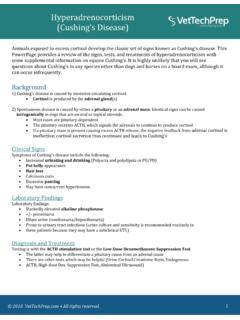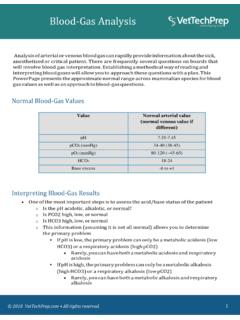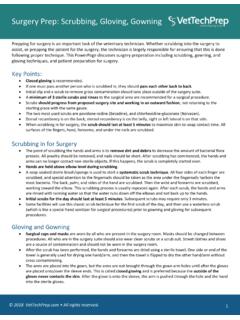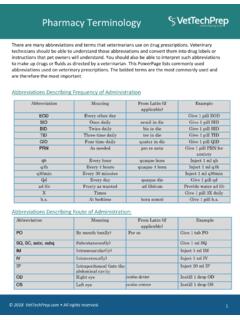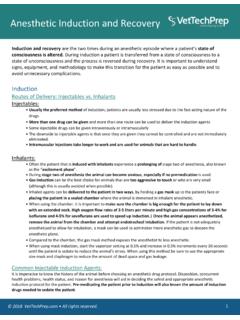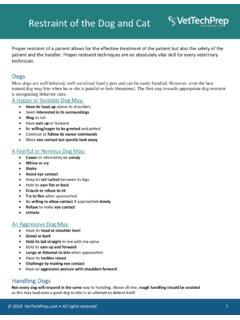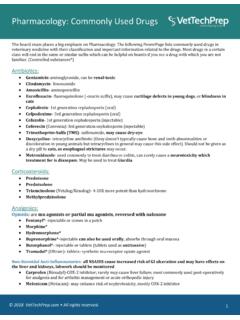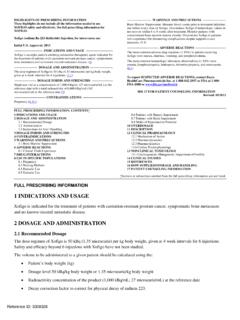Transcription of Medical Calculations - VetTechPrep
1 Medical Calculations The metric system is the most widely used system throughout the world. The system is based on powers of ten. The basic units of measurement are the meter for length, the liter for volume, and the gram for weight (mass). Prefixes are added to the basic unit to form multiples and fractions. Table 1 Decimal System Numerical meaning Metric Prefix Abbreviation Thousand 1,000 Kilo- k Hundred 100 Hecto- h Ten 10 Deka- dk Unit 1 Tenth Deci- d Hundredth Centi- c Thousandth Milli- m Millionth Micro- Metric Conversions: There are two commonly used metric unit conversion methods; the step method and proportion equations.
2 The step method uses movement of the decimal place to the right if converting to a smaller unit, and to the left if converting to a larger unit. Example: to convert 500 milligrams (mg) to grams (g) According to Table 1 500 mg is of a g 1 g is larger than 1 mg, therefore, the decimal must be moved 3 places to the left. Answer: g Perform the proportion equation by cross multiplication Example: to convert 500 mg to g According to Table 1, 1g = 1000 mg Therefore, x g/500 mg = 1 g/1000 mg (x being the unknown number) __x g__ = __1g__ 500 mg 1000 mg 1000 mg x g = 500 mg x 1 g x g = 500 mg X 1 g 1000 mg x g = g 2018 All rights reserved.
3 1 Converting Metric Mass: As mentioned above, the gram is the standard unit for mass. The non-metric unit is the pound. The majority of the medication doses are mg/kg, therefore, when this is the case, the technician must always convert pounds to kilograms before performing the calculation . 1 kg = lbs to convert pounds to kilograms: lbs Example: 45 lbs = kg dosage Calculations : The dose is the amount of medication measured (mg, mL) The dosage is the amount of medication based on units per weight of the animal (50 mg/kg, 10 mL/kg) The concentration of the drug is calculated by the manufacturer (mg/mL, mg/tablet) A kg mixed breed dog is scheduled for an orthopedic procedure today and the veterinarian in charge has asked you to give a Cefazolin injection at a dosage of 22 mg/ kg.
4 The concentration of Cefazolin is 100 mg/mL. How many mL of Cefazolin will you administer to the dog? To calculate the dose in milligrams, use the following formula; weight (kg) dosage (mg/mL) = dose Example: the patient weighs kg and the dosage is 22 mg/kg kg 22 mg/kg = 451 mg (the dose is 451 mg) To calculate the dose in milliliters, use the following formula; dose (mg) concentration (mg/mL) = dose (mL) Example: 451 mg 100 mg/mL = mL (you will administer mL to the patient) The same patient will be going home with carprofen the following day. The dosage is mg/kg twice daily. The veterinarian would like you to dispense 5 days worth.
5 Carprofen comes in 25mg, 75mg, and 100mg chewable tablets. What is the dosage , what size tablet should be used, and how many tablets will you dispense? Example: kg mg/kg = 45 mg The dosage is 45 mg twice daily, you will choose 100 mg tablets and give twice daily, dispensing 5 tablets. *Drugs are manufactured in a variety of concentrations; therefore, it is extremely important to always record the milligram dosage of the drug given on the patient s record. Dilutions and Solutions: Solution: mixture of substances made by dissolving solids in liquids or liquids in liquids. Solvent: solution capable of dissolving other substances.
6 Solute: substance that is dissolved in liquid Dilution: reduction of a concentration of a substance. Diluent: agent that dilutes 2018 All rights reserved. 2 Medical Calculations The concentration of the substance is the amount of solute dissolved in the solvent. Concentrations are expressed as; volume per volume (v/v), weight per volume (w/v), or weight per weight (w/w). When calculating the percent strength of a solution (w/v) use the following formula; mass (g) volume (ml) = concentration (g/ml) Example: What is the strength of a solution if 1g of powder is dissolved in 200 ml of liquid?
7 1g 200 ml = To find the percent multiply by 100: ( 100 = ) Also calculate what the concentration is per mL: *Remember that there are 1,000mg in 1g 1000 mg 200 ml = 5 mg/ml (Also since you already calculated that the percent concentration is , you can move a decimal place to the right to know that the concentration is 5 mg/mL) Percent solution Calculations are used to prepare a specific concentration of solution. Example: The veterinarian has asked you to prepare a Dextrose solution to administer to a patient using 1000 ml of Lactated Ringers solution (LRS).
8 The dextrose concentration is 50%. First you will take the percent solution you want ( ) and multiply it by the amount of liquid you will be adding it to (1000 ml). Then you will divide that by the concentration of solution you have (50%). Remember that to multiply or divide by the %, move 2 decimals to the left (so is equal to and 50 % is equal to ) (which is the same as ) 1000 = 25 25 50% (which is the same as ) = 50 (Note: this is the same a doubling it for 50% solutions) 50 mL of 50% dextrose will need to be added to 1000 ml of LRS The concentration of a solution can also be expressed as a ratio; 1:100 = 1g / 100 ml = 1% / 10 mg/ml Example: The veterinarian asks you to give a patient 400 mg of enrofloxacin intravenously.
9 The concentration of enrofloxacin is First you convert to mg/ml ( mg/ml). To do this easily, simply add a zero to the percentage ( 20% solution has 200 mg/mL, a 10% solution has 100 mg/mL and so on; in this case, since the percent has a decimal, it is the same as moving a decimal place to the right so you get mg. A 10% solution is the same as a % solution, moving a place to the right will give you the 100 mg/mL you were calculating). Then you divide the concentration you want by the concentration you have. 400 mg mg/ml = ml mL of enrofloxacin will need to be administered to the patient.
10 Drip Rates The following formula is used to calculate a drip rate to deliver solutions: Drip rate = volume of solution (mL) drops/mL time (seconds) The volume of solution (mL) is the amount of solution to be administered. Drops per mL is the calibrated amount of the administration set usually indicated on the packaging. Time (seconds) is the amount of time that the fluids are to be administered. 2018 All rights reserved. 3 Medical Calculations Example: What is the drip rate if the volume of solution is 1 L, the drops per mL are 15, and the time is 1 hour?
